SPECviewperf 8.0.1 Performance
For our SPECviewperf tests, we will look at graphs of the overall weighted scores for each viewset. We have also listed the scores for the individual tests for each viewset. For each section, we will begin by listing the description of the viewset from the SPEC website.
For futher details on how SPECviewperf scores are compiled, please see the
SPEC website.
All cards were set to their default professional graphics settings, whatever those happened to be, before running SPECviewperf.
3dsmax Viewset (3dsmax-03)
"The 3dsmax-03 viewset was created from traces of the graphics workload generated by 3ds max 3.1. To ensure a common comparison point, the OpenGL plug-in driver from Discreet was used during tracing.
The models for this viewset came from the SPECapc 3ds max 3.1 benchmark. Each model was measured with two different lighting models to reflect a range of potential 3ds max users. The high-complexity model uses five to seven positional lights as defined by the SPECapc benchmark and reflects how a high-end user would work with 3ds max. The medium-complexity lighting models use two positional lights, a more common lighting environment.
The viewset is based on a trace of the running application and includes all the state changes found during normal 3ds max operation. Immediate-mode OpenGL calls are used to transfer data to the graphics subsystem."
The FireGL V5000 comes very near the performance of the X3-256 under the 3DStudio Max section of the SPECviewperf test. Off to a good start, our suspicion is aroused as to how a slower card with less memory, fewer pixel pipes, and a smaller memory bus could pust such numbers.
But it only gets better from here.
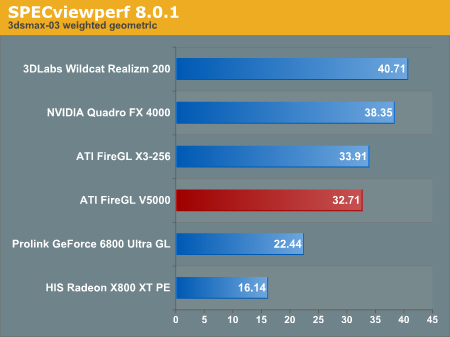
| SPECviewperf 8.0.1 3dsmax-03 |
| |
1 |
2 |
3 |
4 |
5 |
6 |
7 |
8 |
9 |
10 |
11 |
12 |
13 |
14 |
| Wildcat Realzim 200 |
38.6 |
38 |
30.2 |
24.3 |
74.1 |
62.1 |
43.5 |
40.4 |
28.3 |
68.7 |
24.1 |
24.1 |
18.3 |
18.3 |
| Quadro 4000 |
38.6 |
38.5 |
21.8 |
18.8 |
75 |
53.7 |
40.6 |
30.6 |
17.2 |
70.3 |
25.3 |
26.2 |
21 |
20.1 |
| FireGL X3-256 |
32.2 |
27.3 |
23.4 |
18.5 |
62.8 |
51 |
28.9 |
31.9 |
18.6 |
66.6 |
20.5 |
20.6 |
16 |
16.1 |
| FireGL V5000 |
33.5 |
23.5 |
24.3 |
15.9 |
65.1 |
43.2 |
24.2 |
31.5 |
15.7 |
66.1 |
22.7 |
21.6 |
18.4 |
14.3 |
| GeForce 6800 U GC |
17.5 |
15.9 |
14.8 |
14.7 |
42.4 |
29.2 |
27.1 |
19.1 |
14.9 |
40.8 |
14.2 |
14.1 |
11.5 |
11.2 |
| Radeon X800 XTPE |
12 |
8.09 |
12.5 |
10.7 |
35.9 |
23.6 |
11.6 |
15.8 |
10 |
32.7 |
11.4 |
6.37 |
9.3 |
7.86 |
CATIA Viewset (catia-01)
"The catia-01 viewset was created from traces of the graphics workload generated by the CATIATM V5R12 application from Dassault Systemes.
Three models are measured using various modes in CATIA. Phil Harris of LionHeart Solutions, developer of CATBench2003, supplied SPEC/GPC with the models used to measure the CATIA application. The models are courtesy of CATBench2003 and CATIA Community.
The car model contains more than two million points. SPECviewperf replicates the geometry represented by the smaller engine block and submarine models to increase complexity and decrease frame rates. After replication, these models contain 1.2 million vertices (engine block) and 1.8 million vertices (submarine).
State changes as made by the application are included throughout the rendering of the model, including matrix, material, light and line-stipple changes. All state changes are derived from a trace of the running application. The state changes put considerably more stress on graphics subsystems than the simple geometry dumps found in older SPECviewperf viewsets.
Mirroring the application, draw arrays are used for some tests and immediate mode used for others."
The V5000 jumps up ahead of the X3-256 here. Both still trail the Realizm 200 and FX 4000. Remember that the V5000 has lower latency unbuffered RAM to deal with, so it may be having an easier time reaching its potential than the cards on the Opteron system.
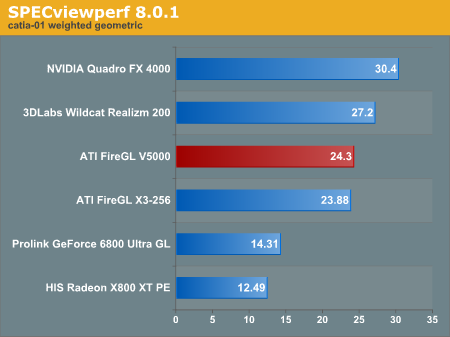
| SPECviewperf 8.0.1 catia-01 |
| |
1 |
2 |
3 |
4 |
5 |
6 |
7 |
8 |
9 |
10 |
11 |
| Quadro 4000 |
48.9 |
37.2 |
26.9 |
27.9 |
19 |
47.8 |
29.6 |
28.9 |
19 |
23.2 |
46.1 |
| Wildcat Realizm 200 |
52.1 |
38.6 |
15.8 |
29.7 |
18.9 |
63.3 |
32.5 |
27.6 |
22 |
20.6 |
13.7 |
| FireGL X3-256 |
39.7 |
25.8 |
19.1 |
22.8 |
16.2 |
34 |
25.2 |
18.8 |
15 |
19.1 |
34.8 |
| FireGL V5000 |
42.6 |
27.6 |
20.8 |
24.1 |
14 |
38.6 |
26.9 |
20.3 |
16.3 |
17.1 |
38.2 |
| GeForce 6800 U GC |
20.2 |
22.5 |
11.5 |
12.6 |
8.9 |
31.1 |
17.2 |
4.49 |
11.2 |
12.7 |
27.2 |
| Radeon X800 XTPE |
20.9 |
10.3 |
10.9 |
11.7 |
7.38 |
26.7 |
13.1 |
12.5 |
8.86 |
7.41 |
21 |
EnSight (ensight-01)
"The ensight-01 viewset replaces the Data Explorer (dx) viewset. It represents engineering and scientific visualization workloads created from traces of CEI's EnSight application.
CEI contributed the models and suggested workloads. Various modes of the EnSight application are tested using both display-list and immediate-mode paths through the OpenGL API. The model data is replicated by SPECviewperf 8.0 to generate 3.2 million vertices per frame.
State changes as made by the application are included throughout the rendering of the model, including matrix, material, light and line-stipple changes. All state changes are derived from a trace of the running application. The state changes put considerably more stress on graphics subsystems than the simple geometry dumps found in older viewsets.
Mirroring the application, both immediate-mode and display-list modes are measured."
This time around, the ATI FireGL V5000 Trails the X3 by a good margin, but the ATI architecture shows an advantage over the rest of the pack that puts the V5000 in second place.
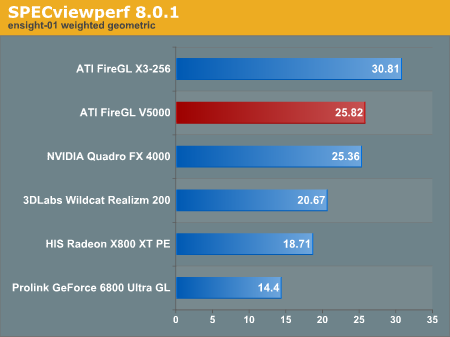
| SPECviewperf 8.0.1 ensight-01 |
| |
1 |
2 |
3 |
4 |
5 |
6 |
7 |
8 |
9 |
| Quadro 4000 |
42.7 |
35.4 |
35.6 |
31.1 |
13.7 |
13.6 |
31 |
13.8 |
31 |
| Wildcat Realizm 200 |
24.5 |
20.9 |
26.7 |
23 |
16 |
15.9 |
23 |
16 |
23 |
| FireGL X3-256 |
53.6 |
50 |
53.7 |
44.6 |
12.3 |
12.3 |
44.7 |
12.3 |
44.6 |
| FireGL V5000 |
37.2 |
34.2 |
45.2 |
35.2 |
12 |
12.5 |
35.2 |
12.4 |
35.2 |
| GeForce 6800 U GC |
11.6 |
3.98 |
39.3 |
34.1 |
7.22 |
7.23 |
34 |
7.26 |
34 |
| Radeon X800 XTPE |
14.1 |
54.4 |
45.5 |
34.8 |
5.84 |
5.78 |
34.8 |
5.8 |
34.8 |
Lightscape Viewset (light-07)
"The light-07 viewset was created from traces of the graphics workload generated by the Lightscape Visualization System from Discreet Logic. Lightscape combines proprietary radiosity algorithms with a physically-based lighting interface.
The most significant feature of Lightscape is its ability to accurately simulate global illumination effects by pre-calculating the diffuse energy distribution in an environment and storing the lighting distribution as part of the 3D model. The resulting lighting "mesh" can then be rapidly displayed."
Here there's another tie between the ATI FireGL V5000 and the FireGL X3-256. These cards trail the top two by about 8 percent.
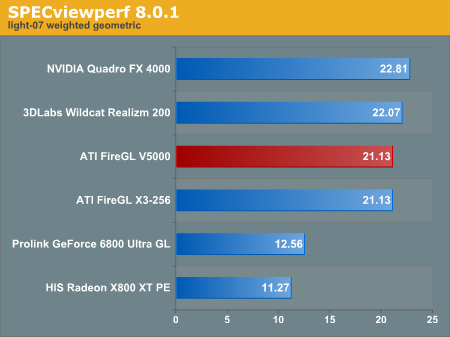
| SPECviewperf 8.0.1 light-07 |
| |
1 |
2 |
3 |
4 |
5 |
| Quadro 4000 |
23.7 |
37.5 |
18.1 |
13.8 |
27.8 |
| Wildcat Realizm 200 |
25.4 |
44.3 |
14.1 |
12.8 |
25.8 |
| FireGL X3-256 |
24.8 |
44.5 |
12.5 |
11.6 |
24.2 |
| FireGL V5000 |
25.2 |
46.9 |
13.5 |
10.3 |
25.6 |
| GeForce 6800 U GC |
13.2 |
24.2 |
9.06 |
6.75 |
16 |
| Radeon X800 XTPE |
12.1 |
22.6 |
7.96 |
5.89 |
14.2 |
Maya Viewset (maya-01)
"The maya-01 viewset was created from traces of the graphics workload generated by the Maya V5 application from Alias.
The models used in the tests were contributed by artists at NVIDIA. Various modes in the Maya application are measured.
State changes as made by the application are included throughout the rendering of the model, including matrix, material, light and line-stipple changes. All state changes are derived from a trace of the running application. The state changes put considerably more stress on graphics subsystems than the simple geometry dumps found in older viewsets.
As in the Maya V5 application, array element is used to transfer data through the OpenGL API."
Under Maya, the V5000 surpasses the performance of the X3. This is due to a combination of the fact that the Maya test is very line and point centered and the platform advantages of the platform we tested the V5000 in offer it an advantage.
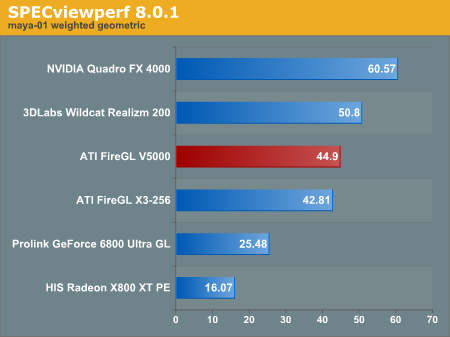
| SPECviewperf 8.0.1 maya-01 |
| |
1 |
2 |
3 |
4 |
5 |
6 |
7 |
8 |
9 |
| Quadro 4000 |
152 |
52.5 |
37.2 |
42.6 |
27.6 |
100 |
82.3 |
82.7 |
49.6 |
| Wildcat Realizm 200 |
126 |
41.1 |
30.8 |
33.3 |
17.7 |
96.3 |
79.8 |
76.8 |
44.7 |
| FireGL X3-256 |
110 |
33.3 |
23.2 |
29.2 |
20.6 |
82 |
51.1 |
63.7 |
37.2 |
| FireGL V5000 |
115 |
35.4 |
24.5 |
30.4 |
21.1 |
85.5 |
56.4 |
66.3 |
38.8 |
| GeForce 6800 U GC |
54 |
24.5 |
16 |
12.8 |
10 |
52 |
39.5 |
37.4 |
23.7 |
| Radeon X800 XTPE |
25.2 |
14.9 |
9.02 |
8.03 |
7.2 |
36.1 |
26.7 |
25 |
16.3 |
Pro/ENGINEER (proe-03)
"The proe-03 viewset was created from traces of the graphics workload generated by the Pro/ENGINEER 2001TM application from PTC.
Two models and three rendering modes are measured during the test. PTC contributed the models to SPEC for use in measurement of the Pro/ENGINEER application. The first of the models, the PTC World Car, represents a large-model workload composed of 3.9 to 5.9 million vertices. This model is measured in shaded, hidden-line removal, and wireframe modes. The wireframe workloads are measured both in normal and antialiased mode. The second model is a copier. It is a medium-sized model made up of 485,000 to 1.6 million vertices. Shaded and hidden-line-removal modes were measured for this model.
This viewset includes state changes as made by the application throughout the rendering of the model, including matrix, material, light and line-stipple changes. The PTC World Car shaded frames include more than 100MB of state and vertex information per frame. All state changes are derived from a trace of the running application. The state changes put considerably more stress on graphics subsystems than the simple geometry dumps found in older viewsets.
Mirroring the application, draw arrays are used for the shaded tests and immediate mode is used for the wireframe. The gradient background used by the Pro/E application is also included to model the application workload better."
Again with the PRO/E test, the V5000 performs exceedingly well. A glance down at the tables will show that the FireGL V5000 is actually the top performer in a couple of the individual tests.
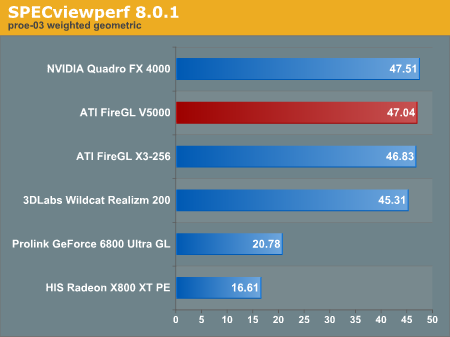
| SPECviewperf 8.0.1 proe-03 |
| |
1 |
2 |
3 |
4 |
5 |
6 |
7 |
| Quadro 4000 |
26.6 |
31 |
24.9 |
53.4 |
53.2 |
170 |
52.6 |
| Wildcat Realizm 200 |
27.1 |
31.8 |
24.5 |
54.2 |
45.2 |
143 |
51.3 |
| FireGL X3-256 |
38.3 |
45.9 |
31.7 |
38.4 |
36 |
135 |
42.9 |
| FireGL V5000 |
40.4 |
47.2 |
27 |
41.2 |
38.8 |
145 |
45.7 |
| GeForce 6800 U GC |
11.2 |
13.1 |
15.3 |
33.5 |
8.55 |
88.5 |
32.7 |
| Radeon X800 XTPE |
7.33 |
8.63 |
9.05 |
22.7 |
22.5 |
44.2 |
23.8 |
SolidWorks Viewset (sw-01)
"The sw-01 viewset was created from traces of the graphics workload generated by the Solidworks 2004 application from Dassault Systemes.
The model and workloads used were contributed by Solidworks as part of the SPECapc for SolidWorks 2004 benchmark.
State changes as made by the application are included throughout the rendering of the model, including matrix, material, light and line-stipple changes. All state changes are derived from a trace of the running application. The state changes put considerably more stress on graphics subsystems than the simple geometry dumps found in older viewsets.
Mirroring the application, draw arrays are used for some tests and immediate mode used for others."
While the V5000 doesn't surpass the X3 this time around, it keeps up rather well with the X3. Solidworks offers quite a few options for texturing and shading that often get used in the real world, this it's fair to say that a part will likely suffer in Solidworks performance a little bit in comparison to a one with more pixel pushing power.
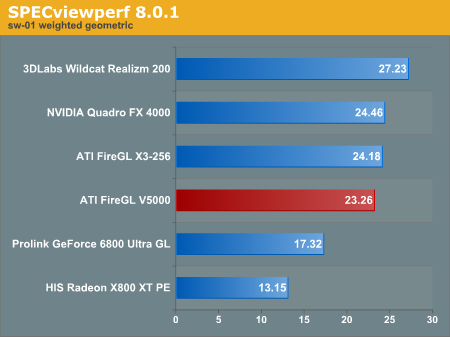
| SPECviewperf 8.0.1 sw-01 |
| |
1 |
2 |
3 |
4 |
5 |
6 |
7 |
8 |
| Quadro 4000 |
34.4 |
12.4 |
14.2 |
17.2 |
40.5 |
28.9 |
49.3 |
21.3 |
| Wildcat Realizm 200 |
43.4 |
9.76 |
12.6 |
15.5 |
48 |
32.7 |
103 |
22.6 |
| FireGL X3-256 |
26.6 |
12.1 |
15.3 |
18.5 |
39.5 |
25.5 |
52.4 |
18.2 |
| FireGL V5000 |
30.4 |
13.2 |
12.9 |
15.6 |
36.2 |
24.7 |
60.3 |
19.7 |
| GeForce 6800 U GC |
31.8 |
10.6 |
10.6 |
13.8 |
32.8 |
12.2 |
33.4 |
12.3 |
| Radeon X800 XTPE |
23.7 |
6.04 |
6.37 |
8.04 |
18.3 |
11.5 |
52.1 |
11.1 |
Unigraphics (ugs-04)
"The ugs-04 viewset was created from traces of the graphics workload generated by Unigraphics V17.
The engine model used was taken from the SPECapc for Unigraphics V17 application benchmark. Three rendering modes are measured: shaded, shaded with transparency, and wireframe. The wireframe workloads are measured both in normal and anti-alised mode. All tests are repeated twice, rotating once in the center of the screen and then moving about the frame to measure clipping performance.
The viewset is based on a trace of the running application and includes all the state changes found during normal Unigraphics operation. As with the application, OpenGL display lists are used to transfer data to the graphics subsystem. Thousands of display lists of varying sizes go into generating each frame of the model.
To increase model size and complexity, SPECviewperf 8.0 replicates the model two times more than the previous ugs-03 test."
Again, unigraphics pushes the cards a little harder than other programs with things like its transparency test. This isn't just another wireframe pusher, and that's why we see the V5000 fall a little behind. Of course, for a midrange target, the part still does very well.

| SPECviewperf 8.0.1 ugs-04 |
| |
1 |
2 |
3 |
4 |
5 |
6 |
7 |
8 |
| Quadro 4000 |
30.1 |
34.7 |
27.8 |
31.2 |
51 |
62.2 |
47.5 |
49.8 |
| Wildcat Realizm 200 |
24.3 |
26.8 |
22 |
23.2 |
38.8 |
31.4 |
30.2 |
26.7 |
| FireGL X3-256 |
18.5 |
19.1 |
13.9 |
14.4 |
53.4 |
56.4 |
53.7 |
53.3 |
| FireGL V5000 |
17.8 |
19.6 |
14.5 |
15.7 |
47.5 |
41.5 |
47 |
36.3 |
| GeForce 6800 U GC |
3.29 |
3.86 |
3.01 |
3.52 |
27.3 |
31.9 |
4.94 |
7.38 |
| Radeon X800 XTPE |
11.9 |
12 |
9.13 |
9.13 |
22.2 |
22.6 |
22.2 |
22.4 |
In half of the tests, the FireGL V5000 out performed the FireGL X3-256 under the SPECviewperf 8.0.1 test. In the rest of the suite, the FireGL V5000 wasn't very far behind its competition.
We've seen that the new midrange part can handle itself under synthetic conditions, but how about inside of real applications? Let's take a look at some SPECapc tests to find out.


















9 Comments
View All Comments
nadirshakur - Saturday, February 26, 2005 - link
please please please someone tell me what the hell is that thing in the middle, it looks like s-video but has three pins instead of the usual four on s-video i have the card and trying to connect it to my computer, someone please help, thanks!nadirshakur - Saturday, February 26, 2005 - link
nadirshakur - Saturday, February 26, 2005 - link
Draven31 - Wednesday, February 2, 2005 - link
But, it won't fix the occasional OpenGL errors you'll get by risking putting an ATI card in your workstation. No thanks.Shadowmage - Tuesday, February 1, 2005 - link
Damn, that's pretty bad. nVidia's going with a mere THREE vertex shader card?Yeah, I didn't mean to demean your review; I just think that getting $500 performance with a $200 card is rather amusing. That's even better than getting $550 performance (X850XT PE) out of a $400 card (X800 Pro VIVO)!
And yeah, there are some driver hacks that let you install the workstation drivers on an UNMODIFIED consumer card.
DerekWilson - Tuesday, February 1, 2005 - link
Shadowmage ...There are a few other factors that go into it, but the silion they've stuck on there is the same as the x700.
The differences are the fact that the X700 lacks the 2 Silicon Image TMDS transmitters for 2x dual-link dvi, the stereo connector, has a different bios, and also uses different drivers. Build quality is also generally better with pro boards, and cap/resistor/pcb layouts are slightly different in some cases.
The reason we focused on the hardware rather than on the consumer part from which it is derived is that we are going to take a look at NVIDIA's 3 vertex 8 pixel workstatoin design shortly. We would rather see NVIDIA go with a 6 vertex 8 pixel design for their workstation as well, but this would have meant deviating from their consumer desing (6600). It just so happened that ATI was lucky and their consumer part fit what we wanted to see in a midrange workstation.
We want to encourage NVIDIA and ATI to look at their workstation parts as requiring different silicon. Maybe eventually they will actually start doing things the right way with respect to the end user. Of course, maybe I poured that message on a little thick at the beginning, but we feel it's very important.
By the way, there was actually a guide to modding r3xx cards to their respective fgl cards on adrian's rojak pot in january. We haven't seen documentation on modding r4xx based cards into the fgl v series. It's interesting to note that it's not enough to simply flash the bios and install the drivers -- ati makes it more difficult than that.
Derek Wilson
Shadowmage - Tuesday, February 1, 2005 - link
LOLThis is just the X700 with a different driver! :D
phaxmohdem - Tuesday, February 1, 2005 - link
LOL I just found the pricing info. My bad. Great job Anand.And BTW
1st and 2nd Post's bitches!!! (since that seems to be the staple of bragging rights these days for whatever reason.)
phaxmohdem - Tuesday, February 1, 2005 - link
Crap! A story thats been up for nearly 24 hours with no comment love.....Fear not I have not forsaken thee!!
I wish I could find pricing information on this card. Looks to be perfect for my needs dabling in 3D design.